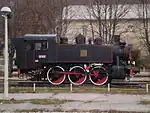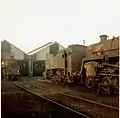| USATC S100 class | |||||||||||||||||||||||||||||||||||||||||||||||||||
|---|---|---|---|---|---|---|---|---|---|---|---|---|---|---|---|---|---|---|---|---|---|---|---|---|---|---|---|---|---|---|---|---|---|---|---|---|---|---|---|---|---|---|---|---|---|---|---|---|---|---|---|
.JPG.webp) Former Southern Railway USA class No. 65 preserved at the Kent and East Sussex Railway | |||||||||||||||||||||||||||||||||||||||||||||||||||
| |||||||||||||||||||||||||||||||||||||||||||||||||||
| |||||||||||||||||||||||||||||||||||||||||||||||||||
| |||||||||||||||||||||||||||||||||||||||||||||||||||
| |||||||||||||||||||||||||||||||||||||||||||||||||||
The United States Army Transportation Corps (USATC) S100 Class is a 0-6-0 steam locomotive that was designed for switching (shunting) duties in Europe and North Africa during World War II. After the war, they were used on railways in Austria, China, Egypt, France, Great Britain, Greece, Iran, Iraq, Israel, Italy, the Netherlands, Palestine, the United States, and Yugoslavia.
Wartime development and use
The S100 is a side tank design by Col. Howard G. Hill. In 1942, the USATC ordered 382 S100s from Davenport Locomotive Works of Iowa, H. K. Porter, Inc, of Pittsburgh and Vulcan Iron Works of Wilkes-Barre. They were shipped to Great Britain in 1943, where they were stored until 1944. After D-Day, they were shipped to Continental Europe.
Construction
| Builders | Construction numbers |
Years | Quantity | USATC numbers |
|---|---|---|---|---|
| H. K. Porter, | 7408 – 7422 |
1942 |
15 |
USATC 1252 – USATC 1266 |
| Vulcan Iron Works | 4365 – 4384 |
1942 |
20 |
USATC 1267 – USATC 1286 |
| Davenport Locomotive Works | 2417 – 2431 |
1942 |
15 |
USATC 1287 – USATC 1301 |
2473 – 2487 |
1943 |
15 |
USATC 1302 – USATC 1316 | |
| H. K. Porter | 7501 – 7512 |
1942 |
12 |
USATC 1387 – USATC 1398 |
7513 – 7550 |
1943 |
38 |
USATC 1399 – USATC 1436 | |
| Davenport Locomotive Works | 2492 – 2516 |
1943 |
25 |
USATC 1927 – USATC 1951 |
| Vulcan Iron Works | 4425 – 4474 |
1943 |
50 |
USATC 1952 – USATC 2001 |
4475 – 4503 |
1943 |
29 |
USATC 4313 – USATC 4341 | |
| Davenport Locomotive Works | 2521 – 2550 |
1943 |
30 |
USATC 4372 – USATC 4401 |
| H. K. Porter | 7460 – 7468 |
1942 |
9 |
USATC 5000 – USATC 5008 |
7483 – 7489 |
1942 |
7 |
USATC 5009 – USATC 5015 | |
7490 – 7501 |
1943 |
12 |
USATC 5016 – USATC 5027 | |
7571 – 7600 |
1943 |
30 |
USATC 5028 – USATC 5057 | |
7616 – 7618 |
1943 |
3 |
USATC 5058 – USATC 5060 | |
| Davenport Locomotive Works | 2589 – 2591 |
1943 |
3 |
USATC 6000 – USATC 6002 |
2592 – 2612 |
1944 |
21 |
USATC 6003 – USATC 6023 | |
| H. K. Porter | 7660 – 7683 |
1944 |
24 |
USATC 6080 – USATC 6103 |
| Vulcan Iron Works | 4530 – 4553 |
1944 |
24 |
USATC 6160 – USATC 6183 |
Use after the Second World War
After the Second World War, SNCF bought 77 S100's and designated them class 030TU. Jugoslovenske železnice (Yugoslav State Railways) bought many S100's and designated them class 62. In the 1950s JŽ assembled more examples bringing the number of class 62 to 129. The Hellenic State Railways in Greece acquired 20 S100's and designated them class Δα (Delta-alpha). Österreichische Bundesbahnen in Austria acquired 10 and designated them class 989. Ferrovie dello Stato in Italy acquired four and designated them class 831.
Several were sold into industrial use in the US, including to Georgia Power[1] and Oklahoma Gas & Electric.[2]
The Oranje-Nassau Mijnen, a coal mining company in The Netherlands acquired two S100's (USATC 4389 and 1948)and numbered them ON-26 (Davenport 2533) and ON-27 (Davenport 2513) respectively. The ON-26 survived the scrapyard and was sold to the museum railway Stoomtrein Goes-Borsele.[3]
The Southern Railway (UK) bought 15 S100's (14 for operational use and one for spare parts) and designated them USA Class. Other S100's entered British industrial use with the National Coal Board, Longmoor Military Railway, Austin Motor Company and others.
China acquired about 20 S100's, designating them class XK2. In 1946, Egyptian State Railways bought eight and numbered them 1151–1158.[4] The UK War Department loaned six to Palestine Railways. In 1946 PR bought two of these, both of which subsequently entered the stock of Israel Railways in 1948.[5]
Iraqi State Railways bought five, designated them Class SA, and gave them fleet numbers 1211–1215.[6] All five were Davenport-built examples. At least two were still in service in March 1967: 1211 at Basrah[7] and 1214 as the station pilot at Baghdad West.[8]
Postwar design influence
Several European railways produced designs based on the S100. JŽ added to their class 62 by ordering several similar examples from Đuro Đaković (factory) of Slavonski Brod, Croatia. These differed in minor details, principally the use of plate frames instead of bar frames, resulting in a higher boiler pitch. This gives the steam pipes a shoulder instead of being straight, and requires smaller domes with a flatter top to fit JŽ's loading gauge.
The British Great Western Railway (GWR) had used many S100s in South Wales during the Second World War. The GWR 1500 Class was partially inspired by the S100 in its use of outside cylinders and short wheelbase.

Continuing commercial use
A small number of former JŽ 62's remain in commercial service, more than 65 years after they were built. At least two work as switcher locomotives (shunter locomotives) at the ArcelorMittal steel plant in Zenica, Bosnia-Hercegovina.[9]
Survival and preservation
More than 100 S100s survive: either preserved, stored, or derelict. Most are in Europe or North America, but there are also two in China and one in Egypt. Project 62 has an online database of them.[10]
Private owners in Baraboo, Wisconsin, are currently restoring S100 #5002. #5002 was used for the Naval Yards in Philadelphia, Pennsylvania, and later sold to the EJ Lavino Company in Pennsylvania, then sold to the Kentucky Railroad Museum.
In 2006, one was purchased for preservation from steelworks in central Bosnia and was sent to Britain.[11]
| USATC No. | Builder | Post World War II Owner | Location | Image |
|---|---|---|---|---|
| 1311 | Davenport 2482 | Anshan Steel XK2-51 | Sujiatun, Liaoning, China | |
| 1396 | H.K. Porter 7510 | JŽ 62-084 | Gračac, Croatia |  |
| 1430 | H.K. Porter 7544 | Benxi Steel XK2-28 | Benxi, Liaoning, China |
In fiction
An engine of this prototype appears in the Thomas & Friends TV series as Rosie.[12]
Gallery
 Southern Railway (GB) USA Class at Eastleigh locomotive depot in February 1967. Photo: Keith Chambers
Southern Railway (GB) USA Class at Eastleigh locomotive depot in February 1967. Photo: Keith Chambers Yugoslav Railways (JŽ) No. 62 070 shunts between Zidani Most and Maribor in August 1971.
Yugoslav Railways (JŽ) No. 62 070 shunts between Zidani Most and Maribor in August 1971. Locomotive (7461 of 1942; originally USATC 5001), operated by the California State Railroad Museum in Sacramento.
Locomotive (7461 of 1942; originally USATC 5001), operated by the California State Railroad Museum in Sacramento. Locomotive 4383 preserved in Longueville dépôt (France).
Locomotive 4383 preserved in Longueville dépôt (France)._in_Goes.jpg.webp) Locomotive 4389 in Goes (Davenport No. 2533)
Locomotive 4389 in Goes (Davenport No. 2533)
References
- ↑ "Locomotives - Southeastern Railway Museum". Southeastern Railway Museum. 22 December 2016.
- ↑ "PORTER 0-6-0T - Oklahoma Railway Museum". Oklahoma Railway Museum.
- ↑ "Loc 4389 van Stichting Stoomtrein Goes Borsele". De Nederlanse Museummaterieel Database (in Dutch).
- ↑ Hughes 1981, p. 57.
- ↑ Cotterell 1984, pp. 71, 134.
- ↑ Hughes 1981, p. 94.
- ↑ "Image no. br670501". The Restoration & Archiving Trust. 2007. Archived from the original on 20 November 2008.
- ↑ "Image no. br670322". The Restoration & Archiving Trust. 2007. Archived from the original on 20 November 2008.
- ↑ "Home". Project 62. Archived from the original on 7 July 2013. Retrieved 31 December 2008.
- ↑ "Project 62's Register of USA Class 62 0-6-0T Steam Locomotives". Project 62. Retrieved 18 September 2020.
- ↑ Walton, Nicholas (12 December 2006). "Britons rescue Bosnian steam train". BBC News. BBC News. Retrieved 18 September 2020.
- ↑ "Rosie – Character Profile & Bio". Thomas & Friends - Official Website. Retrieved 26 August 2017.
- Cotterell, Paul (1984). The Railways of Palestine and Israel. Tourret Publishing. ISBN 0-905878-04-3.
- Hughes, Hugh (1981). Middle East Railways. Continental Railway Circle. ISBN 0-9503469-7-7.
- Russell, J. H. (1991). Pictorial Record of Southern Locomotives. Haynes (Oxford Publishing). ISBN 0-86093-443-8.
- Tourret, R. (1995). Allied Military Locomotives of the Second World War. Abingdon, Oxon: Tourret Publishing. pp. 207–222. ISBN 0-905878-06-X.
External links
- USA 0-6-0T Southern E-Group
- Loc 4389 Stoomtrein Goes-Borsele
- Project 02